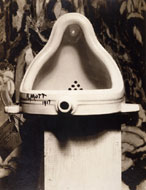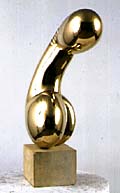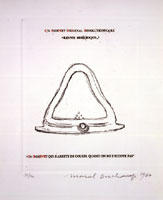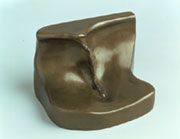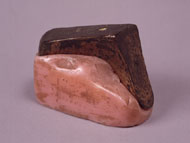|
Rites of Passage:
s / he
|
click
to enlarge |
| |
|
Figure
30 |
|
Marcel
Duchamp, Fountain, 1917
|
| |
|
Figure
31 |
|
Constantin
Brancusi, Princess X, 1916
|
Further elaborating
the domain of the "phallesse"--of such formidably phallic
she-males as "La Broyeuse de chocolat" and "Le Pendu Femelle"
/ "La Guêpe" (femelle)--Duchamp's Fountain (1917) (Fig. 30) analogously redesignates
and, in the process, exactly reverses what would very much appear to be
"un pissoir" (or, otherwise, "un urinoir"),
instead, as "une fontaine". Indeed, Kermit Champa asks,
"Phallic? Vaginal? It was a man-made female object for exclusive
male functions. Yet, who could characterize it precisely?"(43)
Nevertheless Fountain can perhaps be characterized as a "female object" in the
same sense that Duchamp might have described the similarly organic lines
of Brancusi's phallic totem, of only the prior year, Princess X
(1916) (Fig. 31). For Beatrice Wood, indeed,
Fountain was not only the "Madonna of the Bathroom",(44)
but also comparable to "a Brancusi, with curved lines of genuine
sensitivity",(45)
a formal logic perhaps informed by the fact that Fountain and
a version of Princess X were both slated to appear at the 1917
New York Independents exhibition.(46)
But Fountain is also a "female object" according to
another of Duchamp's randy quips: "On n'a que: pour femelle la pissotière
et on en vit" (DDS 37; cf. WMD 23). For those who easily
recall the days of disco, the gist is fairly clear--"I've got what
you want; you've got what I need":
| |
on n'a que = on a queue: we've got dicks
et on en vit = et on envie: and we want [what they've
got]
|
(Or, "where
there's pussy there's prick" ["où il y a Chaliapine"],(47)
as Duchamp elsewhere declares.) Lost in between what "we've got"
and what "we want", however, "pour femelle / la pissotière"
plays by an entirely different set of rules. Although I might as well
be quoting Freud's infamous remarks in his lecture on "Femininity",(48)
yet here too the problem--as in "Le Pendu Femelle" / "La
Guêpe" (femelle)--is "femelle". Like its closest English
translation--which is not really the "female" gender, but
rather the zoological "bitch"--"femelle" frankly
varies from catwalk to dogshow, for exactly which reason Flaubert counsels
its use "only in speaking of animals".(49)
No less problematical, however, is the second and likewise "femelle"
term: "la pissotière". Even so, "We've got dicks, but
all we've got for broads are open holes, and we want them"--taking
both "femelle" and "la pissotière" as crudely reductive
of male desire to the desire for any available opening--doesn't quite
work.
For, behind the
obviously problematic view of feminine sexuality inherent in "pour
femelle / la pissotière", the more fundamental problem is Duchamp's
intent to assimilate the meaningfulness of gender in its psycho-sexual
sense to its meaninglessness--or only circumscribed, even binary meaningfulness--in
any linguistic sense.(50)
By which I mean, why are farmers, pirates and poets all in the conventionally
feminine form in Latin, although grammatically they are masculine, and
in Rome they were paradigmatically men? This is the typically aesthetic
question to which Duchamp likewise reduces gender, most obviously, when
he explains to Cabanne, "If it isn't a literary movement, it's
a woman; it's the same thing".(51)
At this grammatical-as-ontological level, by simultaneously reversing
both the flow and the gender of "un pissoir", instead,
as "une fontaine", Duchamp similarly alienates it from
its expressly male identification by the simple and--like the rose of
Shakespeare and Stein--entirely arbitrary process of renaming it. So,
too, in "Le Pendu Femelle" ["the female of the species
which is male and hangs"], "La Guêpe" (femelle) and its
phallic stinger, as well as the Chocolate Grinderess and its
phallic cabriole "legs", even this process of renaming is,
itself, self-consciously marked and, in this sense, not unlike the use
of "she" as the indefinite personal pronoun, yet definitely
to raise the issue of why "he" is otherwise assumed. Duchamp's
early experience with the failure of English, by contrast, to gender
its articles might even explain the artist's otherwise inexplicable
preoccupation with no sooner arriving in New York than replacing each
occurrence of a gender indefinite "the" with an even more
indefinite "*" in his title text of 1915: The.
| click
to enlarge |
| |
| Figure
32 |
|
Marcel
Duchamp, Nine Malic Molds, 1914-15
|
Nevertheless, the
Nine Male-ish Molds (1914-15) (Fig. 32)--or
"Moules Mâliques [Mâlic (?)]" (DDS 76; WMD 51),
as Duchamp calls them--are perhaps the culminating example of all of this
grammatical-as-ontological play. Although both grammatically ["un
moule"] and descriptively ["mâlique"] masculine, their
vessel-like form is gender ambivalent: whether as uterine-like molds to
condense and cast gas (the enigmatic purpose Duchamp assigns them in the
Large Glass), or as dress forms whose typically male costumes
make (i.e. mold) the man. Yet, if "femelle" carries the double
signifying burden of "bitch", "mâle"--although obviously
the foil to "Le Pendu Femelle" / "La Guêpe" (femelle)
and "pour femelle / la pissotière"--carries no such double connotation.
As applied to the species, it means male; as applied to men, manly. Rather,
Duchamp descriptively emasculates the Molds, not as "mâle", but rather as "mâlique" or "mâlic"
(i.e. "male-ish") more as we might speak of clothes making the
drag king than the man. Like Rrose Sélavy--the "female-ish"
dress form, which is often confused with an alter ego (as if there were
any ego in any of this, in the first place)--the dress-form Molds
similarly identify the constructedness of language and of dress to that
of gender more generally. Indeed, if "mâlique" constitutes an
invented, feminine form of the adjective "mâle" (in the sense
that "-ique" tends to form the feminine), only further confusing
matters, "mâlic" restores Duchamp's neologism to an equally
invented, male-ish form (-"ic") --albeit one which is, itself,
derived from an invented, female-ish form (again, "-ique").(52)
Exactly confounding logic, then, we have "Le Pendu Femelle"
/ "La Guêpe" (femelle), which are clearly insertive, yet are
located in the upper register of the Large Glass: the so-called "Bride's Domain". On the other hand,
we have the Male-ish Molds which by definition are receptive, yet
are classed among the elements of its lower register: the so-called "Bachelor
Apparatus". With the phallic "Bride" on top, lording it
over her receptive "Bachelors" at bottom (cf. DDS 58;
WMD 39), feminine and masculine in their psycho-sexual no less
than their linguistic sense--rather than meaningfully contingent, historical
and political, coordinates--become meaninglessly binary axes, and these,
along an overarching grid of indifference.
Circles are straight. They are a straight line. --
"Joey" (53)
Becoming Full
Circle: From PiRr to πR2
Like the "circularity"
of the Bicycle Wheel, Coffee Mill and Chocolate Grinder -- or the tautological "I" they posit, whose
final determinant is only the "not-I" to which their onanism
opposes itself -- clad not only in the black leather of a Fresh
Widow, but also in "pi", the very figure of the circle,
Rrose Sélavy embodies an alternative (meta)physical trajectory. As Duchamp
describes her:
|
...en 6 pi
qu'habillarrose Sélavy
= [Fr]ancis
Picabia, Rrose Sélavy
= in sex,
[it is] "pi" that clothes eros, such is life(54)
|
| click
to enlarge |
| |
| Figure
33 |
|
Marcel
Duchamp, An Original Revolutionary Faucet: Mirrorical Return,
1964
|
In this sense, however,
revolution no longer describes a circular process of onanism, but rather
a rotational process of sexual involution--no longer a going around and
around, but rather a turning inside-out--as in Duchamp's engravings, Mirrorical Return (1964) (Fig. 33). Here, above
a line drawing of Fountain, the artist writes "an original
revolutionary faucet / 'mirrorical return'"; and below it, "a
faucet which stops running when we're not listening". In some sense,
the logic of a faucet "mirrorically returned" as a urinal is
only a variation on the circular theme with which we are already familiar.
Thus, the named, but not reproduced (effluent) faucet appears in Mirrorical
Return only by way of opposition to what it is not: the (influent)
urinal, which Duchamp does reproduce, as a line drawing of Fountain.
But Duchamp has also found a new binary axis--similar to "le"
/ "la", "mâle" / "femelle", etc.--with only
circumscribed (if any) meaningfulness, by means of which to reclassify
and once again to desublimate sexual identity as a sort of user's manual--"insert
tab A into slot B" --for them for whom neither hunger nor love moves
the world. Duchamp's new binary axis exactly continues his earlier play
on "mâle" / "femelle", now, as plumbing fixtures--or
"Lazy Hardware" as they are sometimes called (DDS 154;
WMD 106)--which are indeed classified as insertive ["tuyau
mâle"] or receptive ["tuyau femelle"], respectively.(55)
Neither is the "mirrorical return" Duchamp stages of "pour
femelle / la pissotière" at all unexpected: "pour mâle / le
robinet"!(56)
Yet what is "original
revolutionary", as the engravings boldly declare, either describes
a faucet caught in the pleonastic grip of advertising or one caught,
instead, in a "revolutionary"--in the sense of rotational--process,
which is itself "original": a sort of sexual spin-cycle, according
to which his sex goes in, her sex comes out; so too faucets go in, urinals
come out. Thus, rather than return Fountain to where it began--as
he does the "handle" of the Coffee Mill, completing its circuit of (de)tumescence--Duchamp brings Fountain
to where it never was, yet in some parallel sense always is. He rotates
it through the "fourth dimension", which exactly accounts
for its sexual involution, with what was an insertive / effluent faucet
"mirrorically returned" as a receptive / influent urinal.(57)
Indeed, that the faucet doesn't actually appear in Mirrorical Return
is precisely Duchamp's (fourth-dimensional) point. For urinal and faucet,
in this sense, are not analogous objects, but rather are alternate manifestations
of the self-same object. At any given time and place, only one aspect
of its essentially dyadic nature is in esse--the other aspect,
by contrast, is always in potentia, and awaits the object's rotation
through the fourth dimension. For this reason, Duchamp elsewhere compares
the process of "mirrorical return" to the effect achieved
by so-called "Wilson-Lincoln" diagrams (DDS 93; WMD
65). Seen from the left, these accordion-pleated diagrams appear to
be Wilson; only at another time and place--a few seconds later, say,
now seen from the right--do they appear to be Lincoln. In this way,
the object has no absolute priority of identity--whether Wilson or Lincoln,
faucet or urinal--but only a relative identity, a pure sexual (ex)change
value, whose coordinates need include not only a place (our three dimensions)
but also a time (the fourth dimension, according to popular understanding).
Although the "Wilson-Lincoln" diagram is destined to remain
among the Large Glass' definitively unfinished elements, yet
the only difference between it, a faucet "mirrorically returned"
as a urinal, and Duchamp's related researches into the fourth-dimensional
field of sexual involution--his 1950s erotic casts which we might never
more accurately describe as "invaginated"(58)--is
one of medium: e.g. Feuille de vigne femelle (1950) (Fig. 34), in
which her trough returns as a peak, if not strictly speaking his
peak; Coin de chasteté (1954) (Fig. 35),
in which a positive form and its negative are indissolubly elided; even
Objet-Dard (1951) (Fig. 36), in
which Eve's rib, from Etant Donnés, instead returns as Adam's (d)art.(59)
No differently than Duchamp reversibly genders sexual identity along
the axes of "le" / "la", "mâle" / "femelle",
he thus "engenders" the figure-ground problem: as a question
not only of three-dimensional versus invaginated / fourth-dimensional
space, but also of real versus virtual space, to which I myself now
turn. >>Next
|
click
on images to enlarge |
|
|
|
|
|
Figure
34
|
Figure
35 |
Figure
36
|
|
Marcel
Duchamp, Feuille de vigne femelle [Female Fig Leaf], 1950/61
|
Marcel
Duchamp, Coin de chasteté [Wedge of Chastity],
1954/63
|
Marcel
Duchamp, Objet-Dard [Dart-Object], 1951/1962
|
page
1 2 3
4 5 6
Notes
 42. Bettelheim, The Empty Fortress, p. 241.
42. Bettelheim, The Empty Fortress, p. 241.
 43. Kermit Champa,
"Charlie was like that", Artforum, vol. 12, no. 7
(March 1974): 58. Following Hopkins' analysis of Fountain in
terms of a proto-fetishistic / homosexual masculinity, Franklin anthropomorphizes
it, as turned on its side and photographed by Stieglitz, into a full-blown
Tea-Room Daddy -- and its "hollow, porcelain protrusion",
in particular, into a "bare, thick, round organ". See Paul
Franklin, "Object Choice: Marcel Duchamp's Fountain and
the Art of Queer Art History", Oxford Art Journal, vol.
23, no. 1 (2000): 26, 33. See also Hopkins, "De-Essentializing
Duchamp", p. 278; "Men Before the Mirror", p. 319.
Yet, by Franklin's own anti-essentialist logic, this "hollow,
porcelain protrusion" is a priori neither phallic nor
clitoral / vaginal, neither effluent nor influent.
43. Kermit Champa,
"Charlie was like that", Artforum, vol. 12, no. 7
(March 1974): 58. Following Hopkins' analysis of Fountain in
terms of a proto-fetishistic / homosexual masculinity, Franklin anthropomorphizes
it, as turned on its side and photographed by Stieglitz, into a full-blown
Tea-Room Daddy -- and its "hollow, porcelain protrusion",
in particular, into a "bare, thick, round organ". See Paul
Franklin, "Object Choice: Marcel Duchamp's Fountain and
the Art of Queer Art History", Oxford Art Journal, vol.
23, no. 1 (2000): 26, 33. See also Hopkins, "De-Essentializing
Duchamp", p. 278; "Men Before the Mirror", p. 319.
Yet, by Franklin's own anti-essentialist logic, this "hollow,
porcelain protrusion" is a priori neither phallic nor
clitoral / vaginal, neither effluent nor influent.
 44. See William
Camfield, "Marcel Duchamp's Fountain: Its History and
Aesthetics in the Context of 1917", in Marcel Duchamp: Artist
of the Century, ed. Rudolf Kuenzli, Francis Naumann (Cambridge,
Mass.: M.I.T., 1990) 74, citing Beatrice Wood, I Shock Myself
(1985).
44. See William
Camfield, "Marcel Duchamp's Fountain: Its History and
Aesthetics in the Context of 1917", in Marcel Duchamp: Artist
of the Century, ed. Rudolf Kuenzli, Francis Naumann (Cambridge,
Mass.: M.I.T., 1990) 74, citing Beatrice Wood, I Shock Myself
(1985).
 45. Beatrice Wood,
"Marcel", in Marcel Duchamp: Artist of the Century,
ed. Rudolf Kuenzli, Francis Naumann (Cambridge, Mass.: M.I.T., 1990)
14. In this sense, the Ready-mades indeed constitute a very specific
sort of object, one in which the immanence of form and function is
as atavistic, even, as the bodily functions to which they often refer.
For, however closely allied Duchamp's and Picabia's interest in mechanomorphic
imagery, when Duchamp undertakes the Ready-mades, he doesn't so much
shift gears as abandon them altogether. How very easy, for example,
to imagine Picabia's spark-plug girl -- Portrait d'une jeune fille
américaine dans l'état de nudité (1915) -- as part of the Large
Glass. How very difficult, by contrast, to imagine a real spark-plug
among the ostentatiously low-tech Ready-mades.
45. Beatrice Wood,
"Marcel", in Marcel Duchamp: Artist of the Century,
ed. Rudolf Kuenzli, Francis Naumann (Cambridge, Mass.: M.I.T., 1990)
14. In this sense, the Ready-mades indeed constitute a very specific
sort of object, one in which the immanence of form and function is
as atavistic, even, as the bodily functions to which they often refer.
For, however closely allied Duchamp's and Picabia's interest in mechanomorphic
imagery, when Duchamp undertakes the Ready-mades, he doesn't so much
shift gears as abandon them altogether. How very easy, for example,
to imagine Picabia's spark-plug girl -- Portrait d'une jeune fille
américaine dans l'état de nudité (1915) -- as part of the Large
Glass. How very difficult, by contrast, to imagine a real spark-plug
among the ostentatiously low-tech Ready-mades.
 46. See William
Camfield, "Marcel Duchamp's Fountain: Aesthetic Object,
Icon, or Anti-Art?", in The Definitively Unfinished Marcel
Duchamp, ed. Thierry de Duve (Cambridge, Mass.: M.I.T., 1991)
152. Picabia's cover for the June 1917 issue of 391 -- depicting
a propeller, but entitled Ane [Ass] -- thus suggests that,
whatever the New York Independents choose to make of "Fontaine",
ultimately, "[ils se] Font Ane[s]" = "[they] Make Asses
[of themselves]," perhaps referring to "Buridan's Ass",
and the problems of choice and free will. Cf. Marcel Duchamp, Notes,
ed. and trans. Paul Matisse (Paris: Centre Georges Pompidou, 1980)
note 101. Picabia's propeller, moreover, captures not only the "circularity"
of the Ready-mades, but also their Brancusi-like resemblance to modern
sculpture. Cf. DDS 242; WMD 160, where Duchamp chastens
Brancusi: "Painting's washed up. Who'll do anything better than
that propeller? Tell me, can you do that?" See Ades, Cox, Hopkins,
Marcel Duchamp, p. 69.
46. See William
Camfield, "Marcel Duchamp's Fountain: Aesthetic Object,
Icon, or Anti-Art?", in The Definitively Unfinished Marcel
Duchamp, ed. Thierry de Duve (Cambridge, Mass.: M.I.T., 1991)
152. Picabia's cover for the June 1917 issue of 391 -- depicting
a propeller, but entitled Ane [Ass] -- thus suggests that,
whatever the New York Independents choose to make of "Fontaine",
ultimately, "[ils se] Font Ane[s]" = "[they] Make Asses
[of themselves]," perhaps referring to "Buridan's Ass",
and the problems of choice and free will. Cf. Marcel Duchamp, Notes,
ed. and trans. Paul Matisse (Paris: Centre Georges Pompidou, 1980)
note 101. Picabia's propeller, moreover, captures not only the "circularity"
of the Ready-mades, but also their Brancusi-like resemblance to modern
sculpture. Cf. DDS 242; WMD 160, where Duchamp chastens
Brancusi: "Painting's washed up. Who'll do anything better than
that propeller? Tell me, can you do that?" See Ades, Cox, Hopkins,
Marcel Duchamp, p. 69.
 47. Duchamp, Notes,
note 265.
47. Duchamp, Notes,
note 265.
 48. See Mary Anne
Doane, "Film and the Masquerade: Theorising the Female Spectator",
Screen, vol. 23, nos. 3-4 (Sept.-Oct. 1982): 74-77.
48. See Mary Anne
Doane, "Film and the Masquerade: Theorising the Female Spectator",
Screen, vol. 23, nos. 3-4 (Sept.-Oct. 1982): 74-77.
 49. Gustave Flaubert,
Bouvard and Pécuchet with "The Dictionary of Received Ideas"
(1881), trans. Alban Krailsheimer, Robert Baldick (N.Y.: Penguin Books,
1976) 305. See also Jones, "Equivocal Masculinity", p. 204
(n. 82).
49. Gustave Flaubert,
Bouvard and Pécuchet with "The Dictionary of Received Ideas"
(1881), trans. Alban Krailsheimer, Robert Baldick (N.Y.: Penguin Books,
1976) 305. See also Jones, "Equivocal Masculinity", p. 204
(n. 82).
 50. Cf. Spector,
Surrealist Art and Writing, p. 226 (n. 70), where he discusses
the French tendency to invest grammar with ontological significance;
Jean Clair, "Sexe et topologie", in Marcel Duchamp: abécédaire:
approches critiques, ed. Jean Clair (Paris: Centre Georges Pompidou,
1977) 59, where he describes Duchamp's works in terms of "a sort
of naive, ontological experience of mathematical ideality, where sexual
differentiation is abolished" (my translation).
50. Cf. Spector,
Surrealist Art and Writing, p. 226 (n. 70), where he discusses
the French tendency to invest grammar with ontological significance;
Jean Clair, "Sexe et topologie", in Marcel Duchamp: abécédaire:
approches critiques, ed. Jean Clair (Paris: Centre Georges Pompidou,
1977) 59, where he describes Duchamp's works in terms of "a sort
of naive, ontological experience of mathematical ideality, where sexual
differentiation is abolished" (my translation).
 51. Duchamp, Cabanne, Dialogues
with Marcel Duchamp, p. 102.
51. Duchamp, Cabanne, Dialogues
with Marcel Duchamp, p. 102.
 52. Robert Lubar
has pointed out to me that "une moule" [a mussel
(feminine)] is French argot for "cunt". Like a "clock"
which doubles as a female-ish / phallic "pendulum" ("Le
Pendu Femelle"), so too the Molds, then, are a sort of
male-ish "cunt".
52. Robert Lubar
has pointed out to me that "une moule" [a mussel
(feminine)] is French argot for "cunt". Like a "clock"
which doubles as a female-ish / phallic "pendulum" ("Le
Pendu Femelle"), so too the Molds, then, are a sort of
male-ish "cunt".
 53. Bettelheim, The Empty Fortress, p. 254.
53. Bettelheim, The Empty Fortress, p. 254.
 54. Amelia Jones,
Postmodernism and the En-gendering of Marcel Duchamp (N.Y.:
Cambridge University, 1994) 287 (n. 35). For variations on Duchamp's
pun, see DDS 151, 159; Duchamp, Cabanne, Dialogues with
Marcel Duchamp, p. 65.
54. Amelia Jones,
Postmodernism and the En-gendering of Marcel Duchamp (N.Y.:
Cambridge University, 1994) 287 (n. 35). For variations on Duchamp's
pun, see DDS 151, 159; Duchamp, Cabanne, Dialogues with
Marcel Duchamp, p. 65.
 55. Cf. Craig
Adcock, "Duchamp's Eroticism: A Mathematical Analysis",
in Marcel Duchamp: Artist of the Century, ed. Rudolf Kuenzli,
Francis Naumann (Cambridge, Mass.: M.I.T., 1990) 153.
55. Cf. Craig
Adcock, "Duchamp's Eroticism: A Mathematical Analysis",
in Marcel Duchamp: Artist of the Century, ed. Rudolf Kuenzli,
Francis Naumann (Cambridge, Mass.: M.I.T., 1990) 153.
 56. On the
"erotic homology between a spigot and a penis", see Franklin,
"Object Choice", p. 47 (n. 114).
56. On the
"erotic homology between a spigot and a penis", see Franklin,
"Object Choice", p. 47 (n. 114).
 57. In sum, a
round-trip ticket to the fourth dimension buys the ticket-holder a
doubly inside-out and left-right reversed welcome home. See Adcock,
"Duchamp's Eroticism", p. 149. Although unobservable in
the case of bilaterally symmetric plumbing fixtures, the potential
for left-right reversal exactly accounts for the Tu m' corkscrew
(on which, see n. 69, herein). On the eroticism of Duchamp's fourth-dimensional
imagery, see Adcock, "Duchamp's Eroticism", pp. 149-67.
On Duchamp's fourth-dimensional imagery more generally, see Craig
Adcock, "Geometrical Complication in the Art of Marcel Duchamp",
Arts Magazine, vol. 58, no. 5 (Jan. 1984): 105-9; Linda Henderson,
The Fourth Dimension and Non-Euclidian Geometry in Modern Art
(Princeton, NJ: Princeton University, 1983) 117 ff.
57. In sum, a
round-trip ticket to the fourth dimension buys the ticket-holder a
doubly inside-out and left-right reversed welcome home. See Adcock,
"Duchamp's Eroticism", p. 149. Although unobservable in
the case of bilaterally symmetric plumbing fixtures, the potential
for left-right reversal exactly accounts for the Tu m' corkscrew
(on which, see n. 69, herein). On the eroticism of Duchamp's fourth-dimensional
imagery, see Adcock, "Duchamp's Eroticism", pp. 149-67.
On Duchamp's fourth-dimensional imagery more generally, see Craig
Adcock, "Geometrical Complication in the Art of Marcel Duchamp",
Arts Magazine, vol. 58, no. 5 (Jan. 1984): 105-9; Linda Henderson,
The Fourth Dimension and Non-Euclidian Geometry in Modern Art
(Princeton, NJ: Princeton University, 1983) 117 ff.
 58. In medical
jargon, the difference is exactly between her "invaginated"
sex and his "external" one, which Duchamp identifies to
the fourth-dimensional process of sexual-as-spatial involution more
generally. Indeed, in Duchamp's fourth-dimensional imagery, "vagina
and penis lose... all distinctive character". Clair, "Sexe
et topologie", p. 58 (my translation). See also Dalia Judovitz,
Unpacking Duchamp: Art in Transit (Berkeley: University of
California, 1995) 212-19; Hellmut Wohl, "Duchamp's Etchings of
the Large Glass and The Lovers", in Marcel Duchamp:
Artist of the Century, ed. Rudolf Kuenzli, Francis Naumann (Cambridge,
Mass.: M.I.T., 1990) 180. Cf. Jones, Postmodernism and the En-gendering
of Marcel Duchamp, p. 91, citing Ecke Bonk, Marcel Duchamp:
The Box in a Valise (1989).
58. In medical
jargon, the difference is exactly between her "invaginated"
sex and his "external" one, which Duchamp identifies to
the fourth-dimensional process of sexual-as-spatial involution more
generally. Indeed, in Duchamp's fourth-dimensional imagery, "vagina
and penis lose... all distinctive character". Clair, "Sexe
et topologie", p. 58 (my translation). See also Dalia Judovitz,
Unpacking Duchamp: Art in Transit (Berkeley: University of
California, 1995) 212-19; Hellmut Wohl, "Duchamp's Etchings of
the Large Glass and The Lovers", in Marcel Duchamp:
Artist of the Century, ed. Rudolf Kuenzli, Francis Naumann (Cambridge,
Mass.: M.I.T., 1990) 180. Cf. Jones, Postmodernism and the En-gendering
of Marcel Duchamp, p. 91, citing Ecke Bonk, Marcel Duchamp:
The Box in a Valise (1989).
 59. On the biblical
referent of the rib imagery, see Adcock, "Duchamp's Eroticism",
p. 162, citing Francis Naumann. In an especially felicitous turn on
the "mâlic" molds, Clair would conversely describe Duchamp's
erotic casts as "femâlic". Clair, "Sexe et topologie",
p. 56.
59. On the biblical
referent of the rib imagery, see Adcock, "Duchamp's Eroticism",
p. 162, citing Francis Naumann. In an especially felicitous turn on
the "mâlic" molds, Clair would conversely describe Duchamp's
erotic casts as "femâlic". Clair, "Sexe et topologie",
p. 56.
Figs.
30, 32-36
©2003 Succession Marcel Duchamp, ARS, N.Y./ADAGP, Paris.
All rights reserved.
|
